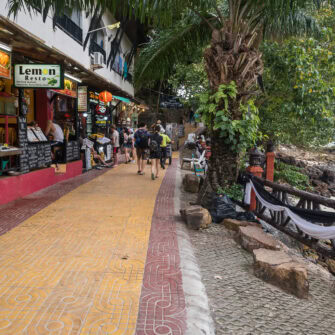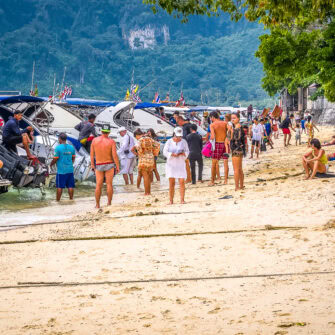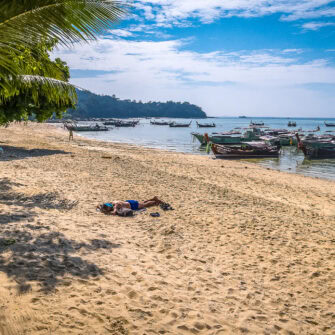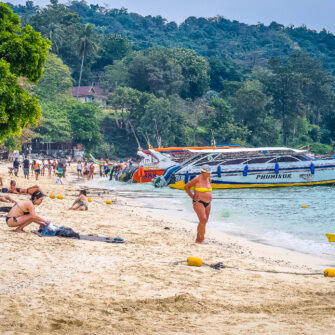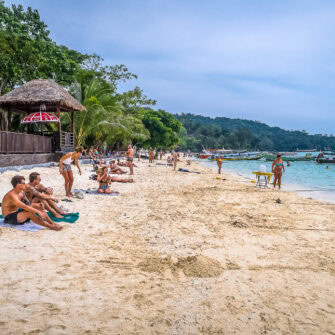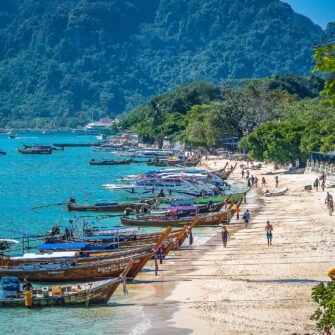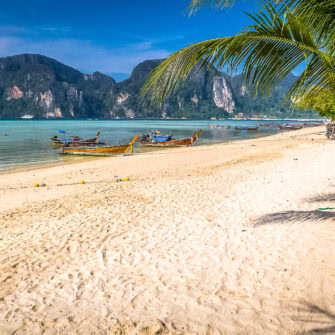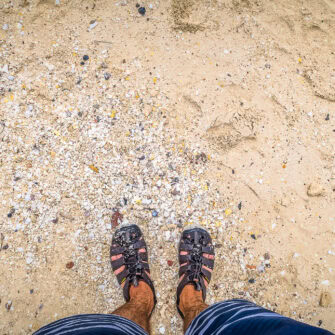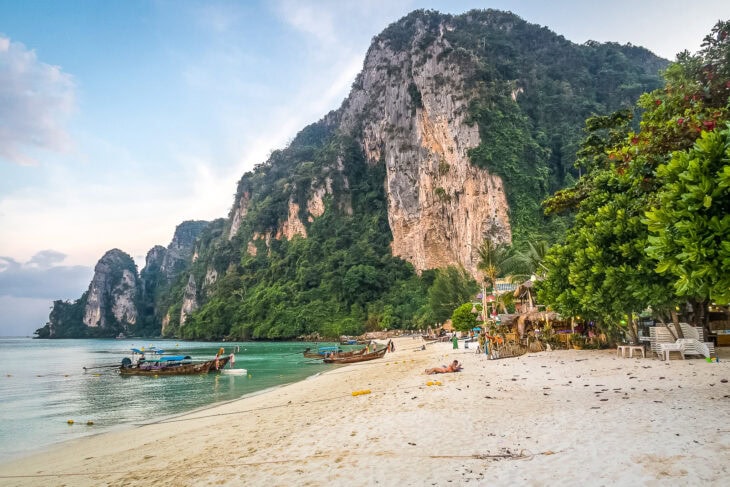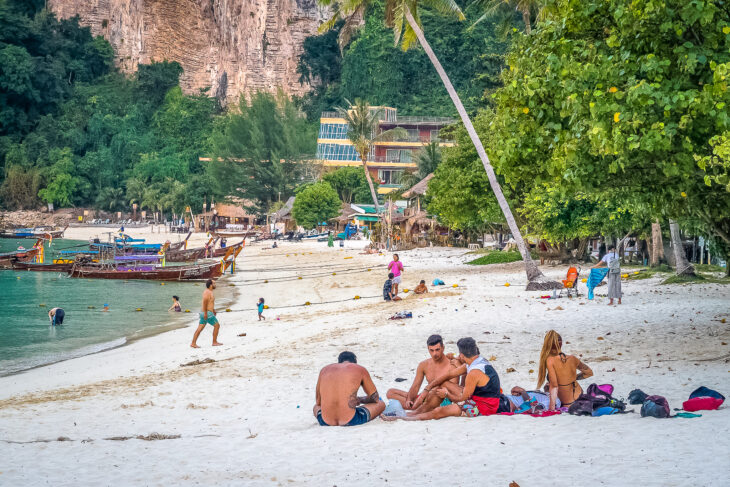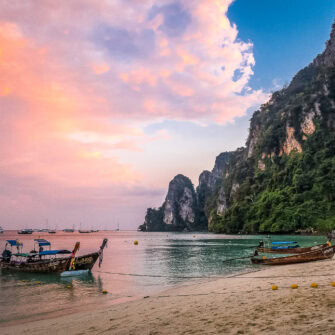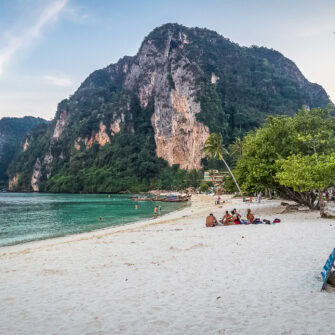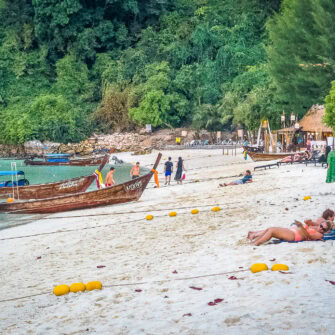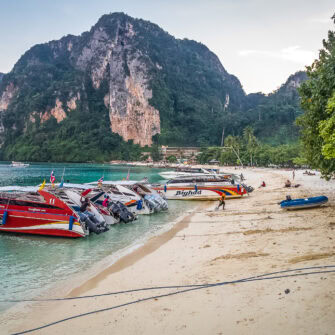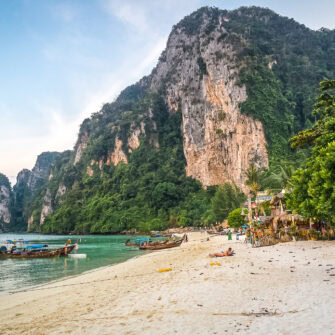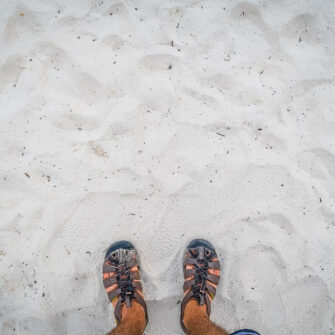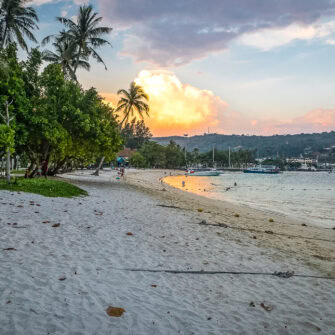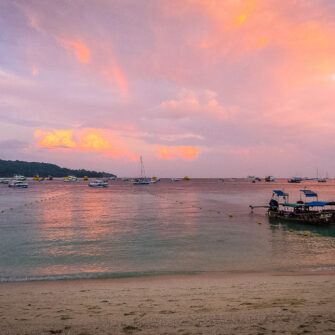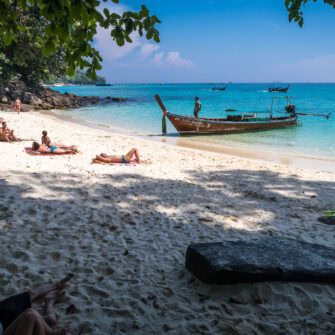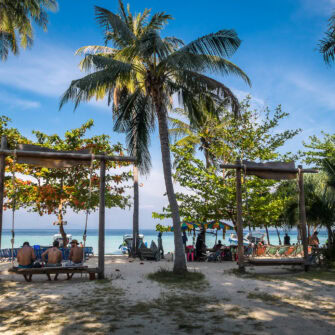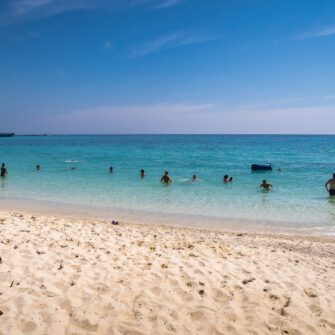Tonsai Beach is the first thing you’ll encounter on Phi Phi Don Island. It’s the southern edge of the island’s isthmus where the only local settlement, Phi Phi Town, is located. Ao Tonsai differs from Lo Dalam (the opposite side of the isthmus) as the central part of the bay here has decent depth.
That’s precisely why they built two piers at Tonsai where all boats and speedboats with tourists arrive. Tonsai Beach on Phi Phi Don has a dual purpose – the central and left parts are swarming with boats and serve as a technical beach while on the right you can find a proper beach resort with clean sea, sand and other holiday amenities.
Beach Overview
The main beachfront is half technical and half resort. I’d divide Tonsai Beach into two parts which are visually striking both in reality and on Google Maps from a bird’s eye view.
On the right edge of Tonsai, the total length of the sandy strip is approximately 4,000 feet (1200 metres), of which only 1,000 feet (300 metres) on the far right edge can be called a proper beach. It’s a bit shallow here but you can swim and there are hardly any boats.
Near the pier and to the left of it, all the way to the cape in the centre of Ao Tonsai, it’s just one big port with loads of longtails along the shore. And the boatmen aren’t exactly concerned about nature, so most of Tonsai is a long string of ropes with boats dangling from them and rubbish scattered everywhere.
The left edge of Tonsai has also been adapted for beach holidays but I didn’t like it there – the sand has lots of impurities, there’s a wall of boats in front of you and behind you is a wall of rocky shore and hotel fences. For sea bathing, shallow areas are cordoned off with rope floats. However, after the cape begins a perfectly decent beach with a fairly wide strip of sand and almost no boats.
There are ropes and boats on the right half of Ao Tonsai too but in much smaller numbers. In general, this edge of the isthmus is surprisingly underdeveloped and large empty spaces, footpaths, old buildings and “straw hut” style bungalows still predominate here.
Compared to the left half, which is bursting with shops and tourist services, the right part of Tonsai looks wild, uninhabited and somewhat uncomfortable in places. Although for those who fancy being away from civilisation, it would be perfect here despite the slightly ridiculous price tag on these very straw huts. It’s clean, quiet, with fine light-yellow sand mixed with pebbles and shells.
Swimming
The left part of Tonsai, which is beyond the cape, has a slight slope and is heavily affected by tides, as indeed are all the other beaches on the island. Closer to the rocks on the right part of the beach.
The shore along the entire isthmus rises only a few feet (few metres) above sea level and has a minimal slope which continues underwater. Closer to the centre, the sea gains depth more quickly, and under the cliffs is the widest part of the shallow bottom.
So waves during strong breezes only occur in the centre, while at the edges they’re felt less. During storm season, needless to say, there will be strong waves everywhere, which is why the shore is partially reinforced with concrete structures that barely spoil the appearance of Ao Tonsai.
During low tide, the beach changes dramatically and the sea retreats from the shore by 150-500 feet (50-150 metres).
Sunbeds and Shade
The width of the beach is not uniform throughout its length. If you look at high tide, there’s no more than 65 feet (20 metres) of sand left by the cliffs, and closer to the centre the width reduces to zero. Hence the situation with sunbeds – there are no rental points on no man’s land, and in front of the rare resorts, sunbeds stand behind symbolic, but still existing, fences. Occasionally you’ll find two or three loungers near bars or massage salons.
The shade along the shore isn’t very dense, but some leafy plants do grow in places. Although I wouldn’t particularly count on natural sources of shade – there are more people and the beach is quite open, and during low tide it becomes several times wider, making it quite a trek to the sea.
Beach Photos
The left side of Tonsai Beach
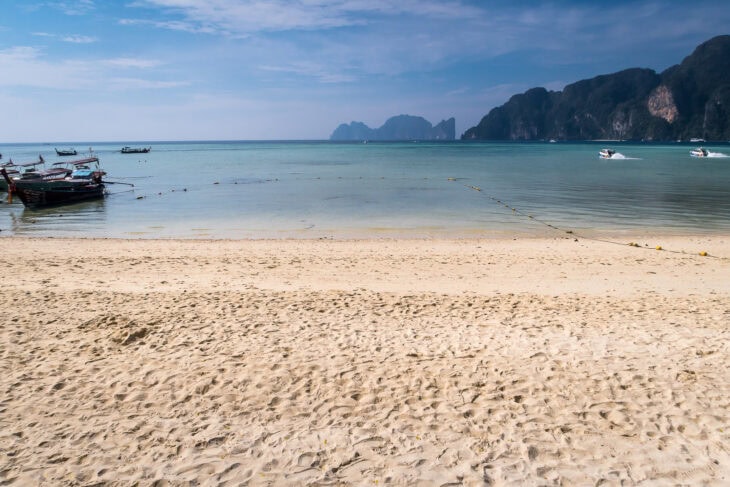
The right side of Tonsai Beach
Amenities
The beachfront of Ao Tonsai from the pier and to the right end is occupied by tourist establishments: bars, restaurants, massage parlours and resorts. There’s the largest medical facility by local standards. Surprisingly, during my entire walk I didn’t see a single Thai shop, let alone chain mini-markets. It’s like some backwater, a residential area Thai-style – everything you need is in Phi Phi Town.
But honestly, walking in the heat from the very edge of Tonsai to Phi Phi Town isn’t the most pleasant pastime. So when staying on the right edge of the beach, always stock up on drinks before returning to your bungalow.
However, from Tonsai pier to the end of the left edge of Tonsai Beach, all offerings of the local tourist infrastructure are available to you. Phi Phi Town starts right from the pier exit and continues into the isthmus. And to the left, along the shore, runs a footpath with heavy traffic – people walk this way towards Viking and Long Beach.
From the sea side, the path is limited only by a kerb stone while on the opposite side there’s a solid row of tourist agencies, cafes, pharmacies and other pavilions with tourist services. You can’t get down to the beach everywhere here and you wouldn’t particularly want to anyway.
Accommodation
On the right half there are about six large hotels, although only the Phi Phi Island Cabana Hotel complex can truly be called a “large hotel”. It’s built on the narrowest part of the isthmus and from this hotel there’s access to both beaches of the island: Tonsai and Lo Dalam. I’ve listed all the decent, noteworthy hotels on the beach separately:
- Phi Phi Cliff Beach Resort
- Phi Phi Nice Beach Hotel Hip
- Phi Phi Sand Sea View Resort
- Phi Phi Island Cabana Hotel
Unfortunately, almost all hotels and resorts on the island suffer from poor service quality and a not-so-careful attitude towards property maintenance. Via the link below, you’ll be redirected to a general list of hotels on Phi Phi Don, but click on the map icon and there you can decide on accommodation options at Tonsai Beach.
How to find the beach
Finding the beach is very simple – just get off at Ao Tonsai pier and you’ll find yourself in the centre of Phi Phi Town. If you stand facing the pier, on your right will be a path towards the beautiful part of Tonsai and on your left towards the technical part of Tonsai Beach.
At first the path will be unclear – it’s too noisy, crowded and you’re being called from all sides with people trying to sell you things. After about 50 metres you’ll escape from this tourist hell and then follow the tile-paved path. There’s only one, along the entire shore.


